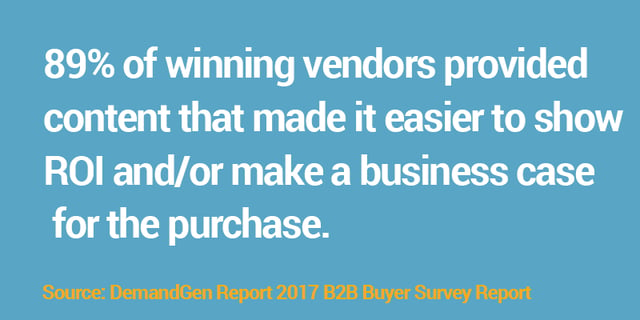
B2B buyer behavior is changing just as rapidly as the technology that fuels it. Those that understand how buyer behavior is changing and adapt their techniques to it will be successful, those who don't will struggle.
As the economy continues to improve and corporate purse strings are loosened, opportunities will abound for professional services businesses. Organizations are increasingly focusing on their core business competencies and outsourcing business functions liking accounting, IT, marketing and legal. This is a good thing for professional services businesses! But to take advantage of these opportunities, you need to be aware of how buying decisions are being made and adjust your sales process accordingly.
DemandGen Report's 2017 B2B Buyer Survey Report, conducted in June 2017, provides a useful insight into how buying decisions are being made. Here are 3 buyer behavior trends from the report that every professional services business should know.
Risk management playing a large role in buying decisions
How many of you have seen an opportunity you thought was a sure thing evaporate into thin air? You're working with a user buyer who assures you your solution is a perfect fit and they just need to finalize a few things internally to make things official. And then, radio silence. Bueller? Bueller? Bueller?
According to the DemandGen report, "a growing focus on risk mitigation is increasing the number of stakeholders involved in buying decisions, as well as adding length and complexity to buying journeys." Sounds about right to me. A bad purchase decision can result in missed opportunities, increased costs and bad consequences for the person who made the decision. In today's risk-averse B2B buying environment, the easiest decision to make is no decision.
I think one of the most telling findings of the DemandGen report is that 89% of buyers reported that the winning vendor "provided content that made it easier to show ROI and/or build a business case for the purchase."

More stakeholders are involved in purchase decisions
It's no longer enough to get the economic buyer (the person whose budget will fund the purchase) on board. One CEO from the DemandGen Report put it this way, "the buying happens with the right stakeholders doing research and me making the final decision based primarily on their input.”
The survey found that 59% of respondents have formal buying committees in place to review processes. It's important for sellers to understand who is involved in the buying process and what their challenges and requirements are. If you don't get everyone on board, your chances of success are minimal.
B2B buying cycles are lengthening
Related to the fact that more people are involved in purchase decisions, buying cycles are lengthening. 58% of respondents in the DemandGen survey found that buying cycles had increased either "somewhat" or "significantly."
Sellers shouldn't give up when the sales process stalls, they should try to find ways to make the business case for the purchase to "unstick" buying decisions. As seen above, this is done most effectively by providing content that makes a business case for a positive decision. This is best done with case studies, technical analyses and third-party reviews and recommendations.
Here are some things you can do to help increase your chances for success in this risk-averse environment:
-
Make sure you understand how purchase decisions are made. Ask your buying contact how the purchase process will take place. Make sure you understand who is involved and what their challenges and requirements are. If your buying contact can't or won't share this information with you, there's a good chance you're being used to fill out a column on a spreadsheet.
-
Be prepared to provide content that makes a business case for buying your solution. This should be verifiable information like case studies, technical analyses and third-party recommendations and reviews.
-
Take longer buying cycles into account in your business planning. If your revenue projections are based on 3-month buying cycles when they're now 6 months, you're going to be disappointed when it's time to measure results. Wishful thinking won't help.
-
Revisit past opportunities that resulted in no decision. These opportunities may now have a higher priority and will likely have reduced buying cycles. Use content strategically to help buyers see the value for revisiting these potential purchases.
The web is the marketplace for B2B purchasing
This shouldn't exactly be news to anyone, but the DemandGen Survey found that the majority of B2B buyers start their purchase process on the web. 61% indicated they started with a broad web search and 56% started on a vendor's website. The research indicates that buyers are conducting anonymous research and drawing up lists of potential providers before engaging with potential vendors.
Another interesting finding of the report was that 63% of respondents saw ads from potential vendors in the research phase of their buying processes. 32% of respondents said that PPC and social media ads positively impacted their views of potential solution providers during the research phase.
What does this mean for professional services businesses?
-
Your website is often the first impression a potential buyer has of your organization. Having a professional website with an intuitive user experience is the foundation of a successful B2B marketing effort. You just can't grow in today's B2B business buying environment with an antiquated website. Yet too many professional services businesses have static, outdated websites that represent their firms terribly. And it's not just a matter of aesthetics - your website needs to have relevant, up-to-date content and perform effectively. If your pages aren't loading within 3 seconds, potential buyers are moving on to the next possibility.
-
Direct prospecting is becoming a low-percentage tactic. If you're cold-calling prospects, you're just not in sync with their buying process. If you do make it past voicemail, the chances of catching someone in a buying process are very low. What you potentially could do is influence someone's buying process, but that's also a low-percentage play. We recommend email prospecting with personalized, highly-targeted emails that drive potential buyers to content that helps educate them and move them through the buying process.
-
If you're not doing PPC and/or social media ads, you should consider doing so. The DemandGen Survey shows that buyers are seeing these ads and they are bringing potential solutions onto their radar screens.
Personalization is a must for success
We've said before that today's buyers are looking for specialists, not generalists. And the DemandGen report bears this out:
-
"75% said it was very important that the site presented relevant content that spoke directly to their company"
-
"66% said it was very important that the website spoke directly to the needs of their industry and the solution provider showed expertise in their area"
-
"93% of respondents valued vendors that “demonstrated experience with/knowledge of our industry.”
If you don't understand the buyer's organization and their industry, your chances of success are minimal. This has several implications for your business development efforts:
-
You need to focus your efforts on a limited number of target niches with which you have intimate familiarity. This means you need to focus limited resources on your target niches and more importantly, not waste time on opportunities outside your targets.
-
You need to publish content that demonstrates your knowledge of your target industries for all stakeholders in the buying process. The user buyer in the cybersecurity industry will have different challenges than the CEO; you need to publish content for both of them.
-
You need to use technology to personalize your content. Rather than send out mass one-size-fits-all emails to a large mailing list, use technology to segment your prospects and create individualized outreaches with content specific to them and their organizations.
It's clear that successful sellers are convincing buyers that they know them and their challenges.
I encourage you to read the DemandGen Report B2B Buyers Survey in full, it contains great information to help you understand the landscape that your buyers inhabit. For many professional services firms, syncing with your buyers will require substantial changes from the way you're selling now. But if you don't make those changes, you will have a hard time growing in today's environment.







